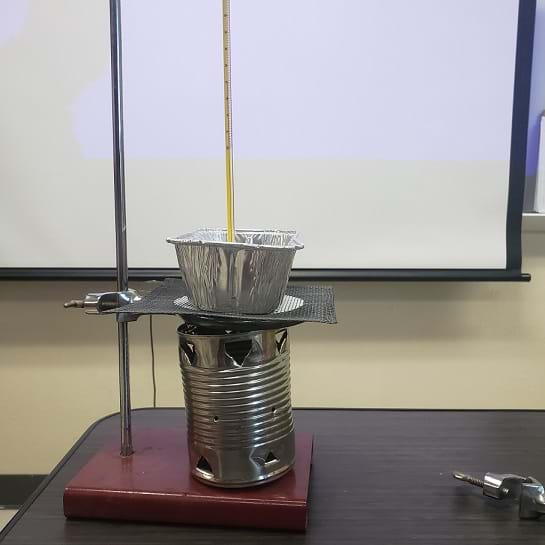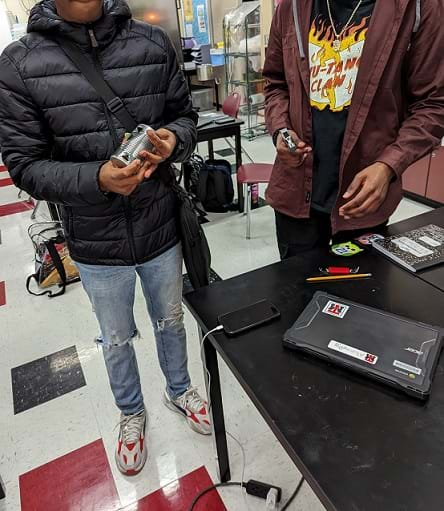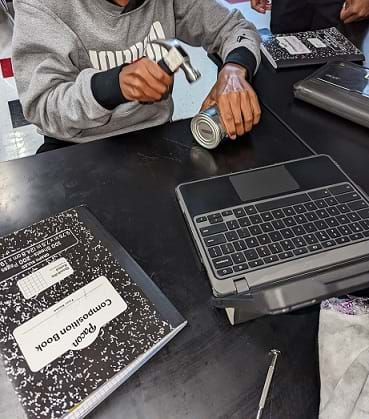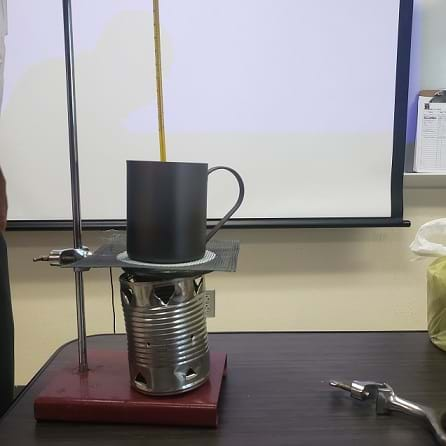Quick Look

Summary
Lack of access to clean cooking affects two-thirds of the global population and disproportionately impacts women. Burn Design Lab in Vashon, WA partners with communities across the globe to design clean cooking technologies. In this activity, students will mimic their work by developing a prototype of a cookstove. They will, as engineers must, engage in human-centered design by tying scientific innovation to human needs, uses, resources, etc. The students will also learn how their work and that being done at Burn Design Lab meets three of the United Nations’ Sustainable Design Goals meant to make the world better. The students will start out working in groups to complete a pre-activity assessment. After that, they will engage in internet research which entails learning about the work done at Burn Design Lab, cookstoves, the UN Sustainable Design Goals, and life in Kenya. Then, they will sketch, plan, and make their prototype. After that, they will test their prototypes. Next, they will evaluate their data and that of their peers before redesigning and retesting their prototype. They will finish by completing a post-activity assessment. Though Kenya is studied in this activity, it can be applied to many different countries and communities.Engineering Connection
Access to clean cooking affects two-thirds of the global population and disproportionately impacts the health and quality of life of women. Burn Design Lab in Vashon, WA partners with communities across the globe to design clean cooking technologies. In this activity, students will mimic their work by developing a prototype of a cookstove. They will, as engineers must, engage in human-centered design by tying scientific innovation to human needs, uses, resources, etc. They will also learn how their work and that done at Burn Design Lab meets the United Nations’ Sustainable Design Goals meant to improve the world.
Learning Objectives
After this activity, students should be able to:
- Understand the role of culture in scientific innovation (human-centered design).
- Apply the engineering design process to create a prototype of a cookstove to support clean cooking.
Educational Standards
Each TeachEngineering lesson or activity is correlated to one or more K-12 science,
technology, engineering or math (STEM) educational standards.
All 100,000+ K-12 STEM standards covered in TeachEngineering are collected, maintained and packaged by the Achievement Standards Network (ASN),
a project of D2L (www.achievementstandards.org).
In the ASN, standards are hierarchically structured: first by source; e.g., by state; within source by type; e.g., science or mathematics;
within type by subtype, then by grade, etc.
Each TeachEngineering lesson or activity is correlated to one or more K-12 science, technology, engineering or math (STEM) educational standards.
All 100,000+ K-12 STEM standards covered in TeachEngineering are collected, maintained and packaged by the Achievement Standards Network (ASN), a project of D2L (www.achievementstandards.org).
In the ASN, standards are hierarchically structured: first by source; e.g., by state; within source by type; e.g., science or mathematics; within type by subtype, then by grade, etc.
NGSS: Next Generation Science Standards - Science
| NGSS Performance Expectation | ||
|---|---|---|
|
HS-ETS1-1. Analyze a major global challenge to specify qualitative and quantitative criteria and constraints for solutions that account for societal needs and wants. (Grades 9 - 12) Do you agree with this alignment? |
||
| Click to view other curriculum aligned to this Performance Expectation | ||
| This activity focuses on the following Three Dimensional Learning aspects of NGSS: | ||
| Science & Engineering Practices | Disciplinary Core Ideas | Crosscutting Concepts |
| Analyze complex real-world problems by specifying criteria and constraints for successful solutions. Alignment agreement: | Criteria and constraints also include satisfying any requirements set by society, such as taking issues of risk mitigation into account, and they should be quantified to the extent possible and stated in such a way that one can tell if a given design meets them. Alignment agreement: Humanity faces major global challenges today, such as the need for supplies of clean water and food or for energy sources that minimize pollution, which can be addressed through engineering. These global challenges also may have manifestations in local communities.Alignment agreement: | New technologies can have deep impacts on society and the environment, including some that were not anticipated. Analysis of costs and benefits is a critical aspect of decisions about technology. Alignment agreement: |
| NGSS Performance Expectation | ||
|---|---|---|
|
HS-ETS1-2. Design a solution to a complex real-world problem by breaking it down into smaller, more manageable problems that can be solved through engineering. (Grades 9 - 12) Do you agree with this alignment? |
||
| Click to view other curriculum aligned to this Performance Expectation | ||
| This activity focuses on the following Three Dimensional Learning aspects of NGSS: | ||
| Science & Engineering Practices | Disciplinary Core Ideas | Crosscutting Concepts |
| Design a solution to a complex real-world problem, based on scientific knowledge, student-generated sources of evidence, prioritized criteria, and tradeoff considerations. Alignment agreement: | Criteria may need to be broken down into simpler ones that can be approached systematically, and decisions about the priority of certain criteria over others (trade-offs) may be needed. Alignment agreement: | |
| NGSS Performance Expectation | ||
|---|---|---|
|
HS-ETS1-3. Evaluate a solution to a complex real-world problem based on prioritized criteria and trade-offs that account for a range of constraints, including cost, safety, reliability, and aesthetics, as well as possible social, cultural, and environmental impacts. (Grades 9 - 12) Do you agree with this alignment? |
||
| Click to view other curriculum aligned to this Performance Expectation | ||
| This activity focuses on the following Three Dimensional Learning aspects of NGSS: | ||
| Science & Engineering Practices | Disciplinary Core Ideas | Crosscutting Concepts |
| Evaluate a solution to a complex real-world problem, based on scientific knowledge, student-generated sources of evidence, prioritized criteria, and tradeoff considerations. Alignment agreement: | When evaluating solutions it is important to take into account a range of constraints including cost, safety, reliability and aesthetics and to consider social, cultural and environmental impacts. Alignment agreement: | New technologies can have deep impacts on society and the environment, including some that were not anticipated. Analysis of costs and benefits is a critical aspect of decisions about technology. Alignment agreement: |
State Standards
Ohio - Science
-
Recognize and analyze explanations and models
(Grades
9 -
12)
More Details
Do you agree with this alignment?
Materials List
Group Needs
For the Pre/Post-Activity Assessment:
- 3-4 markers
- a large piece of easel paper (2 feet by 3 feet), something like Amazon.com: Pacon Easel Pad, Perforated, Unruled, 27" x 34", 50 Sheets, White (PAC3385) : Arts, Crafts & Sewing
For the Stove:
- 2-6 clean tin cans
Class Needs
For the Stoves:
- various tools to place holes in can (i.e., hammers, nails, tin snips, high quality bottle/can openers, pliers, etc.)
- thick gloves/pot holders to safely cut the cans
- sharpies (possibly)
- branches/pipes about the size of the inside of a can (possible)
For Testing:
- 1-8 100 mL graduated cylinders
- 1-8 small aluminum loaf pans or steel mugs
- fire starter (i.e. tiny twigs, newspaper, lighter fluid, etc.)
- Match Light Charcoal (crushed into small chunks)
- a long candle (or other) lighter
- a ring stand
- a wire mesh gauze
- 1-8 disposable mini loaf aluminum pan or steel coffee mugs
- a balance
- a timer
- Safety goggles
- Heat resistant gloves
- 1-8 pair tongs
- 1-8 aprons if you have them
For Extinguishing/Clean Up:
- Dutch oven with lid (waste container for hot coals)
- sand, water, fire extinguisher, etc. for extinguishing fire
Other:
- access to the internet
- cameras
- a smartboard is helpful
- means to show websites and online videos
- possible headphones for the watching of videos independently
Worksheets and Attachments
Visit [www.teachengineering.org/activities/view/uod-2764-clean-cooking-matters-activity] to print or download.Introduction/Motivation
Show: Clean Cookstoves: “Black Inside, Three Women’s Voices”: https://www.youtube.com/watch?v=qm9ODkF4VRo (Timer: 0-10:35 min)
Bring up the Burn Design Lab website (www.burndesignlab.org) while reading the paragraphs below. Also, maybe bring up this website: Youth for Clean Cooking | Clean Cooking Alliance (https://cleancooking.org/reports-and-tools/youth-for-clean-cooking/ )
Almost 3 billion people. Did you know that almost 3 billion people don’t have access to clean cooking facilities in their homes? There are 7.75 billion people in the world so half the globe lacks access to clean cooking. These families have relied on the use of open fires and unsafe traditional cookstoves that cause lots of smoke to fill their lungs, eyes, and home when they cook. This is called indoor air pollution. This indoor air pollution causes respiratory diseases leading to approximately 4 million deaths per year. Several organizations have made it their mission to tackle this issue, including Burn Design Lab (BDL) on Vashon Island, WA.
The United Nations created 17 Sustainable Development Goals (SDG) to improve our world. Goal #2 is Good Health and Well Being, Goal #5 is Gender Equality, and Goal #7 is Affordable and Clean Energy. In support of these SDGs, Burn Design Lab (BDL) is looking for young, innovative engineers to develop a prototype for the next generation of clean cookstoves. They recognize that clean cooking solutions in developing countries bring benefits in terms of health, shorter cooking times, local economic empowerment, and improved quality of life for women. Efficient stoves and clean fuels can also reduce deforestation and local land conflicts
Procedure
Before the Activity
A few weeks/months before,
- ask colleagues, friends, students, etc. to save cans for you. Also, ask around if fellow teachers, etc. can loan you tin snips, hammers, nails, can opener, and other supplies to help you minimize costs. Note: As soon as you get each, you may want to put tape on each item and label it with the name of the person who loaned it to you.
- have a student aid remove the labels, glue, etc.
- watch all of the videos
- secure/decide on a location: a fume hood, an outside heat resistant testing area, etc. (Note: You’ll see in some of the videos that one tested on a tree stump, another tested on large stones, and another tested on slab. Concrete/sidewalk would be safe to test on as well but your school may not want their sidewalk messed up.)
- Reach out to Burn Design Lab to see if someone can skype, FaceTime, etc. with your class. (www.burndesignlab.org; indo@burndesignlab.org; (203) 871-1824; BURN Design Lab, 18850 103rd Avenue SW, Suite 220, Vashon, WA 98070). Make sure they cover the cookstove project in addition to the others. It might be nice to have them skype with your class in the beginning and somewhere in the middle of the lesson. Students might have more questions when they are in the middle of things. A second skype call can also be used to break up the internet research, which is long.
- Read over the entire lesson plan
A few days before,
- Gather materials and make copies of printables or make them available digitally.
- A day or two before starting the testing, get 100 ml - 200 ml water per group and allow it to come to room temperature.
- Have an aid hammer/break the charcoal pieces so that each average piece is broken into about 4-5 pieces.

With the Students
Part 1: Pre-Activity Assessment PowerPoint & Introduction
Show the Pre/Post-Activity Assessment PowerPoint.
Suggested Format:
- Split the students into groups of 2-3. Assign them a Group Number.
- Have them decide on a Group Name.
- Give each group 6 pieces of large (easel) paper and markers.
- Tell them to number each sheet 1-7 at the top.
- Tell them to draw a line down the center and write ‘Pre’ on one half and ‘Post’ on the other half.
- Tell them they will now be writing only on the ‘Pre’ side of their paper.
- Tell them to write as much as they can as you show the Pre/Post-Activity Assessment PowerPoint. Note: Many slides have Guiding Questions which are in the Notes Section. A List of the questions with the guiding questions and answers are provided in the Worksheets and Attachment Section.
- 1. What is clean cooking? Is clean cooking important? Why or why not?
- 2. What does the family structure look like in the US?
- 3. What does cooking at home look like in the US?
- 4. What does the family structure look like in Kenya?
- 5. What does cooking at home look like in Kenya?
- 6. Is knowledge of culture important to scientific innovation (design)? If so, why/how? Provide an example.
- 7. What are engineers doing at Burn Design Lab in Vashon, WA?
- 8. What US Sustainable Development Goals are met by you and the Burn Design Lab working on clean cookstoves? How do they make the world a better place?
- Save their papers so they can add to them during and after the lesson. If possible, allow them to hang on the walls of the classroom throughout the unit.
Introduction
Show: Clean Cookstoves: “Black Inside, Three Women’s Voices”: https://www.youtube.com/watch?v=qm9ODkF4VRo (Timer: 0-10:35 min)
Put the Burn Design Lab website on the smartboard (www.burndesignlab.org).
Read the Introduction and Motivation Paragraphs (from above).
Summarize what the students will be doing in the activity (working as engineers which means working in teams, going through the engineering design process (doing research, building a prototype, testing it, sharing and evaluating data, redesigning and retesting the prototype)).
Part 2: Start the Engineering Journal
Handout/Share the Engineering Journal on paper or digitally according to what works best for your class. Complete the Ask and Constraints Section as a class. Guiding questions for the Need to Know Section:
- Well, do you know what clean cooking is? (Then, that is something you need to know.)
- Do you know what a cook stove is? (Then, that is something you need to know.)
- Do you know how cookstoves are made? (Then, that is something you need to know.)
- Do you know what materials are used to make cookstoves? (Then, that is something you need to know.)
For the Constraints,
Help students brainstorm the constraints that would have to be taken into account if they were working for the people of Kenya. To help them, ask them what they learned when they watched the video in the beginning. These constraints would include cost, availability of resources, and means of getting resources.
Tell the class that people in Kenya may or may not have tin cans, but they (your students) do because that is what’s available to you. Regardless, the work they do in this project can still be used to help the people at Burn Design Lab and the people in Kenya. Help them brainstorm what other constraints there are that need to be considered. This includes that everything must be kept constant when testing (every group using the same sized can and the same type and amount of fuel).
You may want to allow the students to decide how much (what mass of) fuel will be used once they are aware of how much space in the can a certain mass of charcoal occupies. You may want to have some students grab a can and fill it 2/3rds with charcoal and then weigh that amount. Then, the students can decide what mass of fuel they want to use as a class (constraint).
Also, you can help the students see that they are all constrained by testing facilities–we can only either test outside or in a fume hood–and the tools we have available.
Show the students the 4 cookstove videos in the “Constraints” Section of the Engineering Journal. Have them decide on the can constraint: only one can per cookstove, two cans of the same size, two cans of different sizes, etc. Note: In order to get usable scientific data, every group must use cans of the same size.
Part 3: Research
Have students spend a day or so engaged in internet research as outlined in the Engineering Journal (Answering questions from websites and videos.) Save some of the research questions for students to work on independently during the two labs (testing the cookstove and testing the redesigned cookstove). To ensure safety during the labs, it is recommended that you test with each group individually. Thus, the rest of the class will need individual work to do. This format is also recommended because there are a lot of videos they have to view.
Part 4: Imagine (Individual Brainstorm) and Plan (Group Decision)
Continue following the Engineering Journal,
- Tell the students they are to silently draw a detailed sketch for a cook stove showing the exact number, location, shape, and sizes of holes clearly identified. If working with a digital journal, you could have the students sketch on paper and then upload a picture of their sketch. You could also have them sketch digitally. Sign off on that section of their Engineering Journal to ensure all participate and mark it on your roster (if necessary). Perhaps tell the students that the class will not move on until everyone has shown you their sketch.
- Then, have the teams gather to discuss the sketches and decide on the team design. Again, here you will see there is a spot for you to sign off. This is done throughout to ensure that all participate.
Part 5: Design, Build, Test, Evaluate Data, Redesign, Retest, Reevaluate

Continue following the Engineering Journal, Lab I: Testing the Cookstove, Class Data Sheet, and Lab II: Testing the Redesigned Cookstove will also be used at this time.


Part 6: Final Assessment
Return to the Pre/Post-Activity Assessment PowerPoint. Instructions: Get out the large easel papers students filled out for the Pre/Post-Activity Assessment. Tell the students to fill in the ‘Post’ half of their paper. They should have lots of answers in their Engineering Journal.
Alternative Assessment: Have each group prepare a short presentation for the BDL Board of Directors sharing their findings. Each presentation could include:
- Introduction of the team
- Interesting facts from their research
- Why this project was important
- Group's initial design, data, and conclusions
- Group’s redesign including reflection, data, and conclusion
Vocabulary/Definitions
biomass: Organic matter used as fuel.
cookstove: Appliance primarily used for cooking food.
energy: The ability to do work.
fuel: Materials used to produce power.
pollution: The presence in or introduction into the environment of a substance or thing that has harmful or poisonous effects.
sustainable: The quality of not being harmful to the environment or depleting natural resources.
Assessment
Pre-Activity Assessment
Pre/Post-Activity Assessment PowerPoint
Activity Embedded (Formative) Assessment
Post-Activity (Summative) Assessment
Safety Issues
- Wear safety goggles and safety gloves.
- Use caution when cutting metal cans.
- Use caution around flames.
- Test cookstoves in a fume hood or outside. Have a fire extinguisher, water, or Dutch oven available.
- Have a first aid kit available, specifically, Band-Aids.
Troubleshooting Tips
A few weeks before,
- ask colleagues, friends, students, etc. to save cans for you. Also ask around if fellow teachers, etc. can loan you tin snips, hammers, nails, can opener, and other supplies to help you minimize cost. Note: As soon as you get each, you may want to put tape on each tool and label it with the name of the person who loaned it to you.
- have a student aid remove the labels, glue, etc.
- watch all of the videos
- secure/decide on a location: a fume hood, an outside heat resistant testing area (Note: You’ll see in some of the videos that one tested on a tree stump, another tested on large stones, and another tested on slab. Concrete/sidewalk would be safe to test on as well but your school may not want their sidewalk messed up.)
- Reach out to Burn Design Lab to see if someone can skype, FaceTime, etc. with your class. (www.burndesignlab.org; indo@burndesignlab.org; (203) 871-1824; BURN Design Lab, 18850 103rd Avenue SW, Suite 220, Vashon, WA 98070). Make sure they cover the cook stove project in addition to the others. It might be nice to have them skype with your class in the beginning and somewhere in the middle. Students might have questions when they are in the middle of the project.
Other Tips
- Make sure the administration is aware that you will be doing this activity.
- Consider testing (the boiling) over several days so that you can properly supervise the teams. As outlined above, the students can work on their video research during this time when their group isn’t testing.
- Some designs may not actually get the water to boil. View this as a win as it gives students a reason to investigate further. Remind students that failure is not the end but in fact part of the process.
- When testing, you may want to have the Dutch oven in the hood.
- Consider having the students wear aprons (if you have them) and/or encourage the students to wear old clothes and shoes on testing days. They are likely to get dirty.
Activity Extensions
See the Extra Credit Assignment in the Engineering Journal.
Activity Scaling
Some higher performing/upper level students could be required to graph the results (boil time vs number of total holes, boil time vs number of small holes, boil time vs number of medium holes, boil time vs the number of large holes) either by hand or in Excel, Google Sheets, etc. A small group of higher performers could even provide graphs for the class to help the class evaluate the class data. In that case, some of the Testing Lab Questions can be crossed out.
Further upper level students could study thermal efficiency and design and redesign their stoves for improved thermal efficiency. They could also be required to tell why this is important in stove design. This would be very good for an honors physical science, chemistry or physics class.
Additional Multimedia Support
- Needed: access to the internet for research including watching videos, access to cameras; possibly headphones for watching videos independently; access to a smartboard/projector is helpful; a means to show videos is necessary
Subscribe
Get the inside scoop on all things TeachEngineering such as new site features, curriculum updates, video releases, and more by signing up for our newsletter!More Curriculum Like This

Through an overview of some of the environmental challenges facing the growing and evolving country of China today, students learn about the effects of indoor and outdoor air pollution that China is struggling to curb with the help of engineers and scientists.
Other Related Information
Videos
- Cookstove Design #1: https://www.youtube.com/watch?v=uKpar5nvCns
- Cookstove Design #2: https://www.youtube.com/watch?v=o_JLfPrLqOo
- Cookstove Design #3: http://www.youtube.com/watch?v=rvddmcl6iDo
- Cookstove Design #4: https://www.youtube.com/watch?v=deCzUOZyII8
- Nigeria's Okey Esse Creates Clean Cooking Power Stove | Tech Trends - YouTube: https://www.youtube.com/watch?v=sgAunt6omjs
- How Clean Cookstoves Improve Lives - YouTube: https://www.youtube.com/watch?v=Yu5SdH2_0JU&t=9s
- Clean Cookstove Project in Kenya: https://www.youtube.com/watch?v=L65htWQ4EmE&t=72s
- Designing cleaner stoves for the developing world: https://www.youtube.com/watch?v=Z0XrARfLfuk
- Saving Lives Through Clean CookStoves - Ethan Kay Tedexmontreal Ted Talk: https://www.youtube.com/watch?v=J3Zsj4Lfs_o
- https://www.youtube.com/watch?v=NhkqcflxtiI&t=5s
- https://www.youtube.com/watch?v=kQVUYmiEREA
- https://www.youtube.com/watch?v=8v7qZv-D2JE
- https://www.youtube.com/watch?v=ThcppnztYpw
- https://www.youtube.com/watch?v=NorrsBsOnZ0
- https://www.youtube.com/watch?v=dI0WovGPD6c
- https://www.youtube.com/watch?v=pLYXOMCkFHQ
- https://www.youtube.com/watch?v=Q32aZTNP1JE
- https://www.youtube.com/watch?v=ChyPpnQaBs0
Copyright
© 2023 by Regents of the University of Colorado; original © 2022 University of Dayton, Central State UniversityContributors
Marjorie Langston; Delmaria Watts; Kellie R. Schneider, Ph.D. ; Margaret F. Pinnell, PhD; Leanne Petry, Ph.D.; Kelly Bohrer ; Amy Anderson, Ph.D.; Brandy Tang; Erynn HayesSupporting Program
Supporting Program Global STEM Research Experience for Teachers (RET) — Appropriate Technology for Developing Communities, University of Dayton, Central State UniversityAcknowledgements
This curriculum was developed under National Science Foundation RET grant number 1855231/1855239. Any opinions, findings, and conclusions or recommendations expressed in this material are those of the authors and do not necessarily reflect the views of the National Science Foundation.
Last modified: July 17, 2023






User Comments & Tips